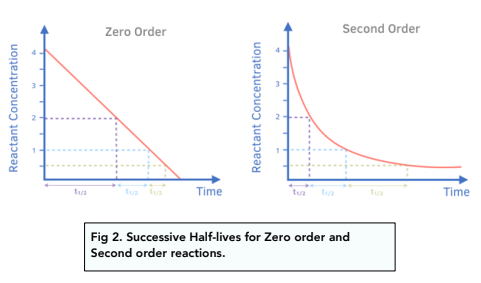Rate Equations - Reaction Half Lives (A-Level Chemistry)
Reaction Half-Lives
Reaction Half Lives
The half life (t1/2) of a reaction is the time taken for the concentration of
a reactant to half.
Calculating Half Lives
The half-life of a reaction can be determined from a concentration-time graph.
Pick a reactant concentration and read from the x axis the time it takes for it to half one, two and three times as shown in the figure below.

Reaction Orders and Reaction Half-life
Half-lives can be used to determine the order of the reaction.
• Zero order – Successive half lives becomes longer
• First order – Half life stays constant
• Second order – Successive half lives become shorter
The concentration-time graph in the figure above shows successive half-lives for a first order reaction. The digram below shows that of zero order and second order reactions:

Rate Constant and Reaction Half-life
The rate constant of a first order reaction can be derived from its half-life using the equation:

A rate equation is an equation that describes the relationship between the rate of a chemical reaction and the concentration of reactants. In A-Level Chemistry, rate equations are used to predict the speed of a chemical reaction and to understand how different factors, such as the concentration of reactants, temperature, and pressure, can affect the rate of a reaction.
In A-Level Chemistry, the rate equation for a chemical reaction is determined by experimentally measuring the rate of the reaction at different concentrations of reactants and then using this data to develop an equation that describes the relationship between the rate and the concentration of reactants. This equation is then used to predict the rate of the reaction at other concentrations of reactants.
The reaction half-life is a measure of the time it takes for half of the reactants in a chemical reaction to be consumed. In A-Level Chemistry, the reaction half-life can be calculated using the rate equation for a reaction. By understanding the relationship between the rate of a reaction and the concentration of reactants, students can use rate equations to predict the reaction half-life and to understand how changes in the concentration of reactants can affect the half-life of a reaction.
Rate equations and reaction half-lives are important concepts in A-Level Chemistry as they provide a way of understanding the behavior of chemical reactions and predicting their outcome. By studying these concepts, students develop a deeper understanding of chemical kinetics, the study of the rates and mechanisms of chemical reactions, and gain the ability to analyze and interpret complex chemical data. This knowledge is essential for understanding and solving a wide range of chemical problems and is useful in many areas, including chemistry, biology, medicine, and engineering.






Still got a question? Leave a comment
Leave a comment